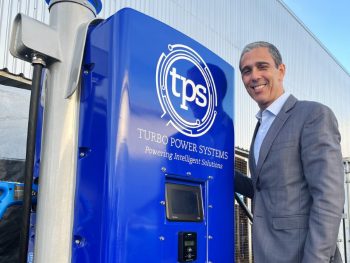Ground-breaking V2X trial showcases future of electric fleets
Pioneering work to develop smart energy micro-grid networks for fleets while proving the benefits of Vehicle-to-Everything (V2X) technology is now underway in the UK, ahead of real-world trials with operators.

TPS CEO Carlos Neves
The project seeks to provide support for the National Grid as EV uptake continues to accelerate, putting rising pressures on energy demand.
The venture explores how energy can be taken from EV batteries to power offices, machinery, homes and other vehicles.
The trial is being led by EV charge point management platform provider Fuuse, which has partnered with engineering firm TPS and Gridicity, a specialist in back-office intelligent energy supply and demand forecasting for EV charging. The trio have received almost £200,000 in government funding under the Flexible Innovation Programme.
The 12-month trial takes place at the Power Network Distribution Centre, based in Cumbernauld at the University of Strathclyde, and will show how smart energy micro-grids give businesses the ability to buy power, store it in vehicles and then distribute it wherever it might need it – to light and heat offices, or run machinery, for example.
Dr Will Maden, COO of Fuuse, explained: “As momentum for EV uptake accelerates and more pressure mounts on fleets to make the transition, we must focus our efforts on resilience, for not only organisation sites, but the wider grid. We must enable fleets to transition as responsibly and efficiently as possible.
“This project is another step toward organisations becoming self-sufficient when it comes to their site energy infrastructure. Fleets who can harness and redistribute their EV battery energy where it is most needed will not only reap operational and financial rewards but become a key player to providing the support the UK will need in its EV rollout goals.”
The project centres around V2X-capable chargers, such as the British-built Velox, developed by TPS and said to be the first ultra-rapid electric vehicle charger that’s already V2X-enabled.
“V2X is the next generation of vehicle charging because it offers fundamental advantages over Vehicle-to-Grid (V2G) systems, of which there are very few operational anyway, while standard chargers that encompass the vast majority of the market have no V2G functionality, let alone V2X,” said TPS CEO Carlos Neves.
“What this trial will look to prove is that you can feed energy already paid for and in your vehicle batteries back into your buildings or machinery, meaning that you can buy electricity at off-peak rates, store it in your fleet, and then use it elsewhere in your business when that energy would be more expensive.
“For example, a business could charge its entire fleet overnight at off-peak rates, and if those vehicles are not needed the next day, it could take that cheap energy and use it to power offices during peak times, or even returning vehicles. The financial benefits of being able to do this are endless when contextualised with large electric vehicle fleets,” Neves said.”
TPS also explained that Vehicle-to-Everything (V2X) is fundamentally different to Vehicle-to-Grid (V2G), because fleets can keep and use the energy they have already paid for, while still having the option to return it to the grid. In V2G you sell that energy back to the grid at a considerably lower price than was paid for it – typically about 5p per kWh. But with V2X, a fleet’s charging infrastructure has a positive return on investment, rather than just being a cost.
The other main benefit is a wider consideration around grid demand, Neves said. As the electric vehicle fleet grows and demand on the grid increases, smart energy management will become an intrinsic part of the system. Velox is already designed to be an integral part of this future network, allowing energy to be drawn when grid supply is lower to then be used more cost effectively when demand spikes.
A further advantage of V2X is operational. Fleets can use Velox to swap energy out of one vehicle and into another, increasing utilisation and reducing cost. If, for example, a vehicle is off-road for repairs and no longer needs the energy stored in it, that energy can be taken out of one and sent to an operational vehicle’s batteries, while for emergency fleets which require constant uptime and readiness, Velox can be used to keep on-alert vehicles topped up.
“When we were designing the concept and then manufacturing the Velox system in Britain, this next-generation charging was foremost in our plans. It means that the investment in Velox will continue to pay dividends for decades, future-proofing your EV charging network,” Neves said.
The first phase of the project will test the concept in a controlled environment. Future developments will include real-world testing with fleets – interested businesses and authorities are being asked to register their interest for future involvement.

